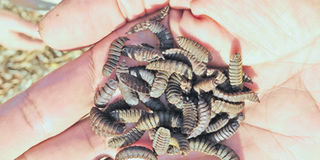Turning your organic waste into nutritious chicken feed

Matured larvae ready to be fed to the chickens at Mwandege breeding facility in Dar es Salaam.
What you need to know:
- An idea new to Tanzanians. Mr Compton, in an interview with Sound Living said, “It’s not a novel idea. I saw a documentary a while back where they used insects not only to feed people but also to feed their livestock. That point of time, I lived in a country, which was very cold and this idea wouldn’t have worked.”
Two years ago, Kigen Compton, an entrepreneur, approached ‘the recycler’, a waste management and recycling solution company in Dar es Salaam with the idea to turn organic waste into chicken feed.
An idea new to Tanzanians. Mr Compton, in an interview with Sound Living said, “It’s not a novel idea. I saw a documentary a while back where they used insects not only to feed people but also to feed their livestock. That point of time, I lived in a country, which was very cold and this idea wouldn’t have worked.”
When Mr Compton moved back to Dar es Salaam, the idea was still stuck with him and thought of all the best ways to implement it here as the climate was favourable.
How does the idea work?
Fish meal is a big part of Tanzania, not only as a staple food for the people, but also widely used as animal feed. Mr Compton’s idea fit well in the Tanzanian environment of producing animal feed that is not only cost-effective but also sustainable.
Upon explaining the science behind the process, Mr Compton begins by saying that an insect native to Tanzanian homes known as a ‘black soldier fly’ produces larvae that is spectacular in consuming waste.
The fly produces eggs, which hatch into larvae that naturally then feed on decaying organic matter (waste). Once the larvae have consumed enough nutrients, they can then harvest themselves into feed for the chickens.
“We have a breeding farm in Mwandege (south of Dar es Salaam) where we have been running tests with the fly.
Now, that we have understood the breeding properly, we want to take a step of producing it at a residential level,” Mr Compton explains.
One of the arms of the project explained by Mr Compton is to target low-income households who own not more than 20 chickens through a receptacle designed like a bin into producing their own chicken feed.
“First we want to educate the households on how to manage waste that is organic waste versus inorganic waste. With this prototype, our main idea is to be able to teach them to use the waste and convert it into something valuable,” Mr Compton adds.
The project will initiate in Dar es Salaam households targeting families who have 1 to 20 chickens. “We have not finalised the cost of the bin and also the actual timeline as it is still in its early stage,” he says.
Substitute recycled food
Fishmeal locally known as dagaa has become a burden to livestock farmers, financially. According to a local buyer, a kilogramme of fishmeal can cost around Sh5,000 to Sh6,000 on an average. Mr Compton says that over-fishing has become a grave problem, such as Lake Victoria is in a terrible state due to this.
“To attain fish meal is environmentally not sustainable due to use of illegal fishing methods such as dynamite fishing that occurs in a large scale,” he says.
Despite lack of policy and poor condition of the fisheries in Tanzania, fishmeal is still used as the main feed for chickens by low-income families. In fact, the fluctuation in the price of fishmeal due to lack of supply has also affected the price rise of chickens.
“With the substituted recycled feed for animals using just a fly, we will not just be cutting down prices to half, but it will also be sustainable to the environment.
In fact, this cost-effective approach will serve as a solution to control waste disposal system,” Mr Compton added an advantage.
Another grave problem as stated by Mr Compton was feeding a growing population that is estimated to reach 9.1billion by 2050, globally.
“The majority of crops that are grown in the world, are not grown for us, they are used to feed animals. And we are living in a world where people starve, there is food insecurity, majority of low-income families cannot even afford one meal per day.
Grain feed such as soy meal can be used to feed people, and that is when we need another way to feed our livestock,” he says.
According to The Food and Agriculture Organisation (FAO), in order to sustain such a huge and increasingly wealthy population, world food production will need to rise by 70 per cent.
The only problem is we may not have enough resources for that. Producing meat takes a lot of input. For instance, in order to produce 1 kilogramme of meat it takes anywhere between 2 – 7 kilogrammes of grain feed depending on the livestock.
Chickens require double the amount of grain than the meat they produce, in cattle it takes around 7 kilogrammes of input of grain to produce 1 kilogramme of weight gain. Nearly 40 per cent of all grain produced in the world is fed to animals.
On this note, Mr Compton adds that we as humans waste so much, at least one family can produce around a kilogramme of waste per day.
“Low-income families produce 200 grammes of organic waste on an average and that amount doubles or triples with a middle-income family. That’s a waste that is not useful.
So it just made sense, we are taking something that has no value at all and converting it into something that has value, not only because you can feed livestock but to combat issues such as overfishing, over-consumption of water and producing grains to feed population,” he adds.
Email: [email protected]




